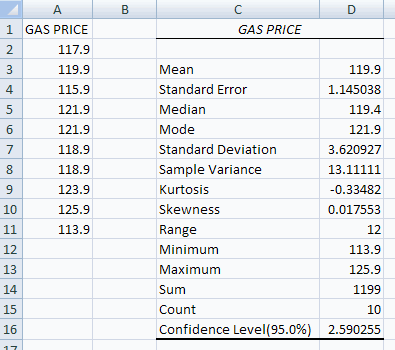
- #CREATE CHART FROM MEAN AND STANDARD DEVIATION EXCEL HOW TO#
- #CREATE CHART FROM MEAN AND STANDARD DEVIATION EXCEL TRIAL#
Include a legend only if neededto distinguish different experimental groups or trials. Each axisneeds a label of what it represents (time, distance, volume, etc.)and the units of measurement. The title of your graph should be descriptive andindicative of what the figure is showing the reader.

Now Excel will ask you to title the graph and label theaxes. Make sure that each axis has the correct data. Remember that the independent variable should be on the X axis andthe dependent variable on the Y axis. The next dialogue box should contain a graph of yourdata. Select the XY (scatter) plot on the left andclick on the picture with the random, unconnected dots on theright. Excel will open a dialogue box and ask you to choose thechart type. Click on the Chart Wizard button in the toolbar (it lookslike a graph with red, yellow and blue bars) or you can click onINSERT and CHART on the drop down menu.ģ.

Tohighlight non-adjacent rows or columns, hold the CTRL button downwhile you highlight the data that you want to include in thegraph.Ģ. The Y (vertical) axis will contain the dependentvariable, which will usually be the mean of your trials. Remember to save your work.ġ. Highlight the data that you want to plot Excel will take thefirst column or row and place it on the X (horizontal) axis, so makesure that the first column or row contains the independentvariable. If you would like to transfer the table you created in Excelto Word, just highlight the cells in the table, select copy, andpaste it in the Word document. You can click on this box and drag the formula down or acrossdepending on where you would also like to use this formula.ĥ.

Or, in the cellwith the formula, there is a tiny black box in the lower right handcorner. You can do this for any formula in Excel. The highlighted cells willautomatically calculate the mean for their respective datasets. Go to Edit, choose Fill from the dropdown menu andselect the direction in which you want to extend the formula (in theexample, it would be Down). In the example forthe mean, the formula is already in G2. Once a cell contains a formula, you can extend it to othercells by highlighting the cell with the formula and the cells towhich you would like to extend the formula. When therecells are highlighted, hitenter.Ĥ. Again, a box will pop up and you should highlight the cellsthat you would like to calculate standard deviation for. Click on the Fx button on the menu bar, choose"statistical" on the left hand side and "STDEV" on the right handside. Place your cursor in the cell where you wouldlike the standard deviation value to be (cell H2 in the aboveexample). In order to calculate standard deviation of a data set, use thefollowing commands. Highlight the numbers you would like to average together andhit enter.ģ. A boxwill pop up that asks you to enter the numbers that you want toaverage. In the left hand column choose"statistical" and in the right hand column choose "average". Put your cursor in the cell that should contain the meanfor the first set of data (cell G2 in the example) and click on theFx button on the menu bar. If you wantto calculate the mean for a set of data, in this example the 5 trialsat one minute, you can use the function option (Fx) in Excel to helpyou do this. If the above table starts at A1,it would extend over to column H and down to row 4. Note that each cell in Excel is on a grid. Include a row for the means and standard deviation of eachtrail.

#CREATE CHART FROM MEAN AND STANDARD DEVIATION EXCEL TRIAL#
Finding the mean andstandard deviation of the data will help you know how accurate andprecise your measurements are.ġ.Enter the data from each trial into one column, creating a table ofyour data. When recording data during alab, you will often perform multiple trials in order to reduce theeffect of error in procedure or measurement.
#CREATE CHART FROM MEAN AND STANDARD DEVIATION EXCEL HOW TO#
The following handout describes how to createdifferent types of graphs in MS Excel and how to make sure therelevant information appears on the graph. Often the easiest and mostinformative way to present the data you recorded during lab is in theform of a graph. BIO270 Laboratory: UsingExcel to Present Data


 0 kommentar(er)
0 kommentar(er)
